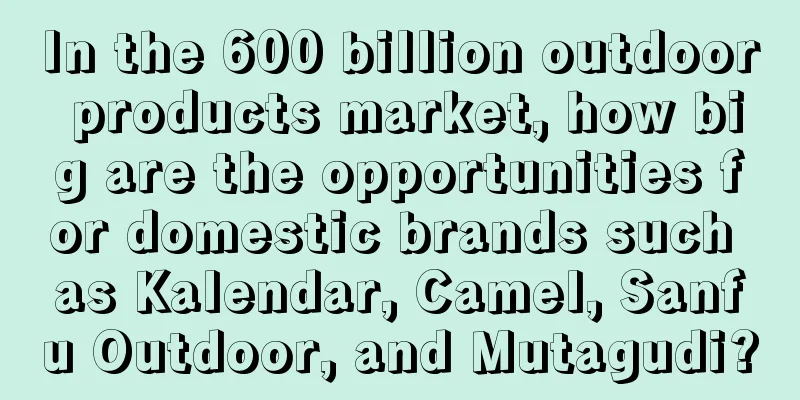In the 600 billion outdoor products market, how big are the opportunities for domestic brands such as Kalendar, Camel, Sanfu Outdoor, and Mutagudi?

As the epidemic has come to an end, the outdoor craze has declined relatively, but there is no doubt that the outdoors has become a new lifestyle. How big is the potential of outdoor activities? Zhang Heng, founder of Sanfu Outdoor, a listed company, recently said: "At a European summit, a speaker listed the four major industries in the United States: oil, automobiles, leisure sports and film and television, and invited everyone on the scene to guess which industry is the largest. I never thought that the leisure sports industry could surpass the automobile and oil industries. This is indeed the case, and I believe that China is now moving in this direction." Lululomon, The North Face, and Arc'teryx have become popular online, and outdoor-related brands such as Amer Sports Group have achieved growth, all of which are demonstrating the power of "outdoors". However, it seems that these popular brands are all foreign brands. In fact, there are many outstanding domestic brands, and domestic brands also have their own advantages. In this article, we will focus on domestic outdoor sports brands and talk about the development opportunities of domestic outdoor consumers and domestic brands. 1. As long-distance travel recovers, is outdoor travel still strong?During the May Day holiday this year, the growth of the cultural tourism market exceeded that of 2019, which greatly boosted the confidence of the industry. However, from the perspective of social media, camping, which became popular in 2020 due to the epidemic, has been somewhat cold. Indeed, after the epidemic, people are free to travel, and they generally choose to travel to more distant provinces and cities instead of setting up a tent locally. Objectively speaking, the actual growth of outdoor and camping this year is still good. During this year's Tmall 38 Renewal Week, new consumption trends related to camping and camping travel continued to rise. The number of searches related to cycling bicycles, jackets, off-road shoes, and wetsuits increased by 70%, and the sales of camping hats increased by nearly 600%. Taking Shanghai as an example, the sales of trekking poles in January-April this year increased by 900% year-on-year, and the sales of other products closely related to mountaineering and hiking increased by 400% year-on-year. Sun Yichao, who has been deeply involved in the camping industry for many years and is also the founder of BLACKDOG, also said, "The average customer price has dropped, but user demand, conversion rate and total sales are all increasing, so the camping market will definitely see a 50-100% growth this year." As a sub-category of the outdoor industry, although camping is the most popular, its overall market size is relatively small. In 2021, the market size of camping camps in China reached 29.9 billion yuan. The annual revenue of domestic listed companies related to camping is also maintained at the level of hundreds of millions to more than one billion, such as Mugodi and Sanfu Outdoor. The entire outdoor products market is relatively large. Public data shows that the scale of my country's outdoor sports products market has increased from 166.9 billion in 2015 to 357.5 billion in 2021, with an average annual compound growth rate of 13.5%. Based on the average annual compound growth rate of the past seven years, it is estimated that the scale of the outdoor sports products market will reach about 600 billion in 2025. In addition to camping, outdoor clothing may have the largest share in the outdoor industry . Compared with fast fashion clothing that always has to keep up with the trend, outdoor clothing has higher functional requirements, such as coping with extreme weather, or basic moisture absorption and perspiration functions. So, in this sense, it can resist the influence of clothing trends better than fast fashion, is more stable, and the market is more likely to grow. When we focus on a track, what we should pay attention to is the crowd. The reason why outdoor activities are popular in China is that, apart from the sudden factor of the epidemic, the popularity of outdoor activities is still continuing. What is the reason behind this? Why has it been popular abroad for so many years, but why is it only now starting to become popular in China? What happened? I think there are 3 indicators that can be used as a reference. First, referring to the development pace of Europe, the United States and Japan, China has just crossed the GDP threshold of 10,000 US dollars, and the economic foundation for the popularization of outdoor sports has been established. Second, there are 60 to 100 million people in the Chinese market who regularly participate in running, and 30 million people who participate in skiing every year, which is enough to support the development of an industry. In Northern Europe, more than 50% of the population regularly participates in outdoor sports every year, and the figure in the United States is more than 48%. The Chinese market will gradually develop to this stage. Third, people born in the 1980s, 1990s, and 2000s have become the main force of outdoor consumption. This group of people is the most important consumer group at present. They are financially independent and have the pressure of starting a family. At this time, leaving the reinforced concrete city and going camping in the wild to "recharge" by absorbing the energy of nature has become a way for young people to relax. The main consumer groups have real needs. Previously, camping brands such as Hi King Wild Luxury Camping, ABC Camping, and Dare Wilderness have also received financing support, and listed companies have increased their investment. These may be the underlying reasons why many capitals are optimistic about the big outdoor industry. 2. OEM and low gross profit margins, the era of domestic outdoor branding is comingCompared with international outdoor brands, there is indeed some gap between domestic outdoor sports brands. For example, The North Face, Arc'teryx, Kolon, Descente, these international brands that have survived for decades or even hundreds of years all have clear positioning and brand value. Arc'teryx clothing, which costs 5,000 yuan per piece, is in short supply, and many of them have become popular among the general public from the niche outdoor sportswear field. The North Face is a brand that has done a good job in street fashion and localization, Arc'teryx is a science student who is anti-fashion, Descente uses the Winter Olympics to bind the skiing subdivision track, and Kolon is a high-end lightweight brand for outdoor camping. These brands are all high-end, but they all have their own unique characteristics. But when it comes to domestic outdoor sports brands, most of them are popular brands, and previously domestic brands have relatively few layouts in the outdoor field. Moreover, since outdoor sports in China were still a niche sport before and demand had not yet taken off, China's outdoor-related companies focused more on the supply chain and overseas expansion. The main business models of my country's outdoor products manufacturers are OEM and ODM, and most of their customers are well-known overseas brands and retailers. For example, the major customers of Mobi's OEM/ODM business are Decathlon, Go Outdoors, Kmart and other brands, and OEM and ODM businesses have long accounted for more than 70% of its revenue. Yangzhou Jinquan, which also specializes in tents, mainly serves internationally renowned brands such as Coleman, The North Face, and Fjallraven. Moreover, the gross profit margins are generally not high. For example, the gross profit margin of Muco is only about 30%, which is an average level; the gross profit margin of Yangzhou Jinquan is also only about 20%, which is lower than the industry average. Therefore, domestic outdoor sports brands lack independent brands and need to improve their understanding of the brand and users and improve product quality. In a sense, the domestic outdoor sports market has experienced a boom, and international brands have reaped the benefits after long-term accumulation. This is normal. Data shows that the penetration rate of outdoor sports in my country will be about 28% in 2022. I am skeptical whether the actual data can reach this ratio, because the average level in Europe and the United States is also above 50%. But in any case, the demand for outdoor sports is real and growing, and domestic outdoor sports brands can also grow with the demand and develop products that are more suitable for Chinese people and more suitable marketing methods. For example, data shows that in terms of specific outdoor activities, the four activities with the highest participation rates are cycling, hiking, mountaineering, and camping, while new projects such as paddle boarding, frisbee, and land surfing have a higher growth rate due to their small base. Some domestic rock climbing facilities or mountain climbing trails are not perfect enough. Nowadays, the demand for outdoor activities has risen, and the supply will gradually catch up. In this process, the increase in high-quality supply will also stimulate more demand. This is the opportunity for domestic outdoor sports brands. 3. What do domestic brands such as Moco, Sanfu Outdoor, Kalendar, and Camel do?For high-end outdoor brands like Arc'teryx, a jacket may cost thousands or even tens of thousands of yuan. Even so, there are still people rushing to buy it, and it has even become a financial product. In fact, the prices of some domestic outdoor sports brands have also risen, but they are not necessarily treated the same way. For example, the price of a jacket from Sanfu Outdoor has risen to 6,000 to 8,000 yuan. The price of a product from Camel ranges from 500 to 1,500 yuan. Kailas also has products priced at 500 yuan and several thousand yuan. The price of quick-drying short-sleeved pants from Skyler is between 100 and 300 yuan. The brands mentioned above and those discussed below are mainly clothing brands in the large outdoor category and the most popular camping-related brands in the past three years. 1. Mutagudi VS Sanfu Outdoor: one gets dividends, the other loses money in the dividends.Muda, which has successfully listed its tents on the market, actually has some commendable aspects. You should know that before this, Muco was a company with only a few hundred million yuan in revenue. Later, after taking advantage of the camping boom, its annual revenue reached 1.436 billion yuan in 2022. Image source: MobiGarden official Weibo Sanfu Outdoor, founded in 1997, was losing money. It was not until the first quarter of this year that it was said to have reversed its performance and achieved positive profits, with revenue of 188 million yuan in the quarter, a year-on-year increase of 43.25%, and non-net profit of 6.8025 million yuan, a year-on-year increase of 482.3%. The difference in their two development directions actually has strategic reasons. For example, Mobi started to develop its own brand very early, starting in 2000, and divided it into two brands, Damu and Xiaomu, in 2018. It also seized the bonus of camping and did a lot of brand promotion activities, such as appearing in variety shows and co-branding with Line Friends, Meizu and other brands. Moreover, according to the financial report, from 2017 to 2022, Muco's sales expense ratio fluctuated and decreased from 8.14% to 6.87%. The revenue was higher and the sales expenses were reduced. This data is really impressive. Sanfu Outdoor has a relatively long development cycle and has gone through a relatively complete cycle of outdoor sports. It has experienced many channel changes, from specialized outdoor brand stores, to online, to opening stores in shopping malls. Sanfu Outdoor's response has been relatively slow. According to Zhang Heng, the founder of Sanfu Outdoor, e-commerce platforms have had sports/outdoor categories since 2013. The entry of Tmall and JD.com has snatched away a lot of offline traffic. In addition, after the rise of comprehensive shopping malls, consumers' eating, drinking, entertainment and shopping are integrated in one place. People do not have so much time to go to an independent street store to buy outdoor products. Sanfu Outdoor has also experienced a loss of traffic and rising rents. Its business is also diversified. In 2020, the revenue from its mask business was close to that from its outdoor business. It also has a large number of distributors and consignment sales, and price control is difficult. In the year of the pandemic, Sanfu Outdoor's investment in camping was relatively conservative. And when its peers were scrambling to build online channels, Sanfu Outdoor's focus was still on offline channels. Image source: Sanfu Outdoor official Weibo Some netizens complained, "Who among the young people in their twenties and thirties knows about Sanfu Outdoor? And those who played outdoors back then can't walk anymore." The aging of customer base, slow channel response, and distraction from diversified business have caused Sanfu Outdoor to suffer consecutive losses. Therefore, Sanfu Outdoor also began to shift from channels to brands, reducing the number of domestic and foreign brands it represented and distributed. Just like Anta Group's acquisition of international brands, it spent 78.84 million yuan to acquire the two core trademarks of "X-BIONIC" and "X-SOCKS" and the ownership of many intellectual property rights in China. In 2022, X-BIONIC accounted for 25% of its revenue, but it is still not a pillar brand. 2. Kalendar: It is known as the "pride of domestic products", but its approach is very similar to that of international brands."Once Decathlon comes out, all domestic outdoor brands have to kneel down, but Kalenji can only kneel halfway." "For the same price of 3,000 yuan, you may not be able to buy a decent bird at Arc'teryx, but you can buy a better product at Kalendar." This is a widely popular evaluation of Kalas on social networks. Public reports show that Kalas's revenue in 2019 was 1 billion yuan. In my opinion, Kalendar’s brand narrative and brand positioning are quite similar to those of international brands. For example, Arc'teryx has always emphasized the spirit of daring to climb; Kalendar has been carrying out the China Unclimbed Summit Plan for 17 years, which organizes climbing activities for mountains that have not been climbed or summited, and the brand provides support for athletes. Image source: KAILAS official Weibo Moreover, in this kind of climbing plan, one thing that Kaleido will do is to develop products based on the needs of athletes and continuously iterate based on their feedback; the same is true for Arc'teryx. For example, its headquarters is very close to an extremely cold mountain, and athletes are often asked to wear samples for testing. It’s just that Arc’teryx often holds mountain classes to popularize related outdoor culture, and is good at collaborating with some niche brands at home and abroad to convey new spirits. Kalas frequently sponsors large-scale outdoor events at home and abroad, and has also had some joint projects in recent years, such as the "Kalas Mountain Image Development Plan" in cooperation with the Kendall International Mountain Film Festival in the UK, and the cross-border collaboration with the classic Chinese animation IP "Havoc in Heaven", and the launch of the Monkey King limited edition MONT hardshell jacket. Image source: KAILAS official WeChat public account 3. Camel: A traditional Chinese brand that is “quickly responsive”.Camel is a traditional Chinese brand founded in 1930 from Tianjin, which started out as a leather shoe brand. Its products include jackets, hiking shoes, sun-protective clothing, and camping tent lights. Camel started to enter the outdoor field in 2000, with products divided into "urban outdoor" and "professional outdoor", targeting both outdoor novices and enthusiasts. Moreover, as an outdoor veteran, Camel has a relatively complete supply chain, such as establishing production and R&D centers in Huanggang, Shaoxing, Foshan, Qingyuan, etc., creating a model of integrated R&D, production and sales, and achieving lower production costs. Moreover, Camel is quite sensitive to new channels. It is understood that it ranks first in search interaction in the jacket category on Xiaohongshu. The sales of the same jacket as Ding Zhen's have exceeded 350,000 pieces. Camel Jacket has also ranked first in sales of jackets on Double 11 for three consecutive years. Image source: Camel Tmall flagship store In addition, the "CAMEL" brand has completed the layout of the entire online e-commerce platform, including Taobao, Tmall, JD.com, Vipshop, Douyin, Kuaishou, etc.; and has opened more than 4,000 offline stores. When domestic brands are following the path of international brands, Camel is trying to find its own way. For example, there is a professional-grade jacket "Everest" series from CAMEL, which is equipped with ENFO superposition technology and is priced at RMB 1,000. It is trying to take a more professional and cost-effective path to share the market share of jackets. IV. SummaryI think some domestic outdoor sports brands have found their own way. In the future, there are still many opportunities for domestic outdoor sports brands, such as the following. Opportunity 1: Market differentiation. Whether it is a camping brand or an outdoor clothing brand, there will be corresponding products and brands from low-end, mid-end to high-end. This is an inevitable thing, and you have to focus on a certain track and do it for a long time. Opportunity 2: Create your own brand. Neither OEM nor OEM is a long-term solution. With such a large population and booming demand for outdoor products in China, independent brands are a must. Sanfu Outdoor, which transformed into its own brand, finally turned a profit in the first quarter of this year, is an example. Opportunity 3: Seize the opportunity of online channels. Some early international outdoor brands were generally sold through domestic professional outdoor offline channels, so they were unknown for a long time, and the construction of online channels was far from enough. However, domestic outdoor sports brands are good at using Internet channels to establish their own product tonality and quickly understand users. This is an opportunity for domestic outdoor sports brands. Opportunity 4: Explore more popular products. Although outdoor activities are exclusive to the wealthy and leisurely middle class, and brands that focus on high-end products often achieve substantial growth, as outdoor sports become more popular, public demand will inevitably increase. Decathlon is not the only brand that can meet people's demand for cost-effectiveness. More brands are needed in different forms to meet the needs of different people and bring new growth points to the outdoor products industry. Author: Jiao Yimeng Source: New Consumption Think Tank |
<<: Looking at 618, the five major platforms’ gameplay preview
>>: Building an omni-channel new retail system - taking pharmacies as an example
Recommend
Can eBay use FBA to ship goods? How does eBay ship goods?
Now more and more merchants are opening stores on ...
Ten thousand words long article: The underlying logic of the successful incentive system
This article starts with several African legends, ...
Is it necessary to pay to register a Google account? How to register a Google email account?
In our country, more and more users are starting t...
Xiaohongshu's Hot Articles in March
The hot articles on Xiaohongshu are different ever...
What are the consequences of abandoning an eBay bid? Can I choose not to buy after successfully negotiating a price?
There are still many buyers who bid on eBay. Altho...
How to view the natural traffic of Amazon products? How to check?
As a newbie, you still don’t know how to look at t...
Capacity growth of private domain operators: How to formulate effective private domain operation strategies
How can private domain operators formulate strateg...
Should I write the address for buying things on eBay in English or Chinese? How does eBay ship things?
Cross-border e-commerce is developing rapidly, and...
What is the difference between Amazon deactivation and account suspension? Why is it deactivated?
When you use Amazon, you usually need to register ...
Amazon: North America or Europe? Which is better?
Amazon's market models in various European cou...
A big year for suspense dramas, a new battlefield for brand marketing
In recent years, suspense dramas have been very po...
How to get Amazon advertising discount coupons?
In order to help sellers attract traffic, Amazon l...
Ten thousand words long article 丨 Deconstructing the AI security industry chain, solutions and entrepreneurial opportunities
This article divides the basic construction of the...
Marketing revelation from 30 years ago
No matter what industry or company you work in, yo...
Can Shopee individual business owners register as a self-employed person? What is the registration process for Shopee individual business owners?
Shopee has been developing better and better in re...









